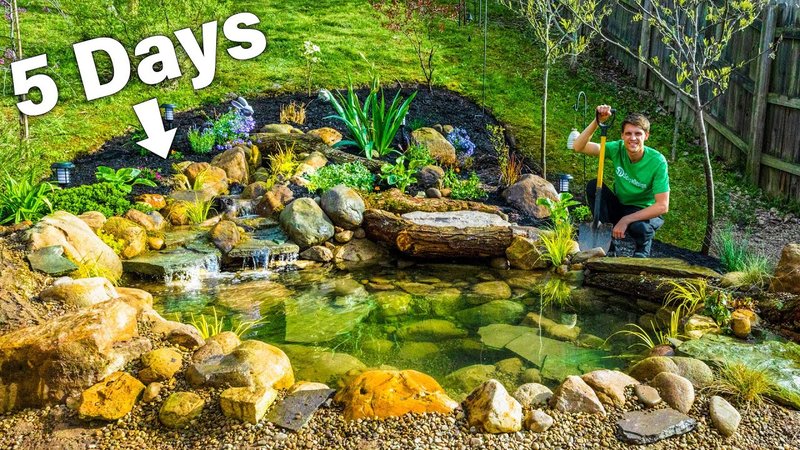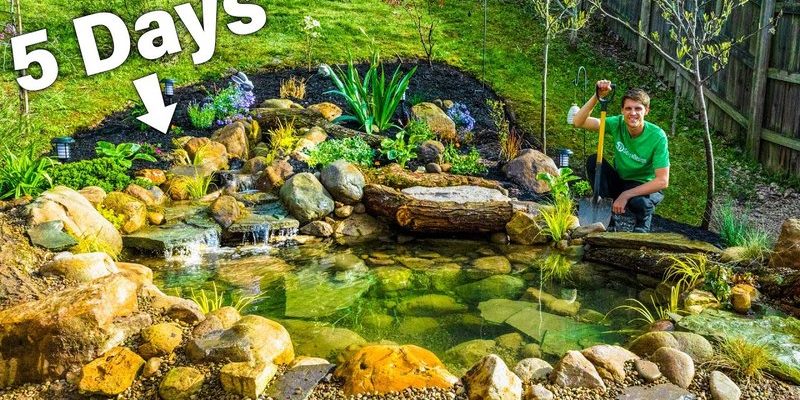
Before diving in, let’s think about what an eco-friendly pond really means. It goes beyond just digging a hole and filling it with water. It’s about using natural methods to maintain a balanced ecosystem, which can provide a home for fish, frogs, and beneficial insects. You might be wondering how to achieve this without the use of harsh chemicals or unnatural materials. Don’t worry! I’ll guide you step-by-step through the process.
Choosing the Right Location for Your Pond
The first step in building your natural eco-friendly fish pond is selecting the ideal location. Think about it like picking the perfect spot for a picnic—it needs to be both practical and inviting. Ideally, you want a place that gets a mix of sun and shade. Too much sun can heat up the water, potentially harming your fish, while too much shade can limit plant growth.
Next, consider proximity to trees. While some shade is good, you want to avoid having too many leaves falling into your pond. Decaying leaves can lead to excess nutrients in the water, which causes algae blooms. If you do have trees nearby, think about how to manage leaf fall during the fall season. Also, make sure it’s a flat area that’s easily accessible for maintenance.
And here’s a bonus tip: avoid placing your pond near drainage areas where contaminants from the soil could wash into it. Look around and visualize what the area will look like with your pond. Picture yourself relaxing nearby—this will help you find the perfect spot.
Deciding on the Size and Shape of Your Pond
Once you’ve found the right location, the fun part is deciding on the size and shape of your pond. There’s no one-size-fits-all solution here—your pond should reflect both your space and your vision. A larger pond can house more fish and plants but requires more upkeep. On the other hand, a smaller pond may create a cozy, tranquil retreat.
When it comes to shape, think about how it will fit into your landscape. Will it have a natural look with curves and bends or a more geometric shape? You might find it helpful to sketch your design on paper. Don’t forget to plan for depth, too! Ideally, your pond should be at least two feet deep to prevent it from freezing solid in winter.
Here’s a quick recap of steps to define your pond’s size and shape:
- Assess your space and envision the pond’s role in your landscape.
- Decide on a size that balances beauty and maintenance.
- Choose a shape that complements your yard and feels natural.
- Ensure it’s deep enough to support aquatic life year-round.
Preparing the Pond Site
With your size and shape sorted, it’s time to prepare the site for your pond. Start by marking your planned shape with string or spray paint. This will help you visualize it on the ground. Then, gather the tools you’ll need: a shovel, a spade, and possibly a garden tiller.
Now, it’s time to dig! This part can be a workout, so grab a friend or two to help. Make sure to create shelves in your pond. These are shallow areas at different depths that allow plants to thrive. Think of it as creating a tiered garden underwater. A depth of about six inches is ideal for aquatic plants, while the deeper center will provide a home for fish.
Once the digging is done, take a moment to check for sharp rocks or roots that could puncture your pond liner if you’re using one. Try to smooth the edges of your pond for a natural look. You might want to create a little beach area where you can sit and enjoy the pond sight.
Choosing the Right Materials for Your Pond
When it comes to materials, eco-friendly options are key. If you’re lining your pond, look for natural pond liners made from materials like rubber or EPDM. These options are durable and safe for your fish and plants. If you choose to go without a liner, that can work too, but it requires more preparation to ensure the earth is compact enough to hold water.
You’ll also want to incorporate natural stones and gravel around the edge. This not only provides a beautiful finish but also helps prevent soil erosion. Think of it as framing your pond—it highlights its natural beauty.
Lastly, don’t forget about plants! You’ll want a mix of submerged, marginal, and floating plants. They help keep the water clean and provide crucial habitats for fish and other wildlife.
Adding Life to Your Pond
Now comes the exciting part: adding fish and plants! Start with native aquatic plants, which are adapted to your local climate and will thrive with minimal effort from you. Look for plants like water lilies, cattails, and anacharis. These plants provide shelter and breeding grounds for fish, helping to create a balanced ecosystem.
When it comes to fish, consider species that are compatible with your pond size and climate. Goldfish and guppies are great for smaller ponds, while koi can thrive in larger setups. Just be mindful not to overcrowd your pond, as this can lead to water quality issues.
Remember: Introducing fish too soon after building your pond can stress them out. It’s best to wait a few weeks for the ecosystem to stabilize, allowing beneficial bacteria to form.
Maintaining Your Eco-Friendly Pond
Maintaining your pond may sound daunting, but it’s really about observing and adjusting. Regular checks on water clarity and temperature are essential. You might want to test the water quality regularly to ensure it remains balanced. Adding beneficial bacteria can help keep the ecosystem running smoothly.
You’ll also want to manage algae naturally. Instead of chemical treatments, consider adding more plants, which can outcompete algae for nutrients. Additionally, introducing snails or certain fish species can help with algae control.
And here’s the thing: maintenance isn’t just about cleaning. It’s about nurturing your pond as it grows. Look for signs of health or distress in your fish and plants. It’ll be an ongoing learning experience that connects you deeper to your little slice of nature.
Enjoying Your Eco-Friendly Fish Pond
As your pond matures, it will become a vibrant habitat that attracts not just fish but all kinds of wildlife. You might find frogs hopping about, dragonflies flitting over the water, and birds stopping by for a drink. It’s a little ecosystem you’ve created, and that’s something to celebrate!
Think about how you want to enjoy this space. Perhaps you’ll add seating or a pathway leading to your pond. Maybe you’ll invite friends over for a picnic by the water. Whatever you decide, take the time to appreciate the beauty and tranquility your natural fish pond offers.
And don’t forget to take photos! Watching your pond evolve over time is rewarding and documenting it can inspire others to embark on their own eco-friendly pond journey.
Building a natural eco-friendly fish pond is much more than digging a hole; it’s creating a living, breathing sanctuary for you and local wildlife. By planning thoughtfully and choosing the right materials, you’ll nurture an environment that brings joy to you and countless creatures. Happy pond building!

